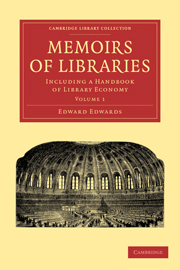Book contents
- Frontmatter
- Preface
- Contents
- LIST OF THE ILLUSTRATIONS
- Dedcation
- BOOK I THE LIBRARIES OF THE ANCIENTS
- CHAPTER I INTRODUCTORY
- CHAPTER II GENERAL VIEW OF THE LIBRARIES OF THE ANCIENTS
- CHAPTER III PASSAGES FROM GREEK WRITERS RELATING TO ANCIENT LIBRARIES
- CHAPTER IV PASSAGES FROM LATIN WRITERS RELATING TO ANCIENT LIBRARIES
- CHAPTER V THE DESTRUCTION AND DISPERSION OF ANCIENT LIBRARIES: AND THE RESEARCHES AFTER THEIR FRAGMENTS
- BOOK II THE LIBRARIES OF THE MIDDLE AGES
- BOOK III THE MODERN LIBRARIES OF GREAT BRITAIN AND IRELAND
- Plate section
CHAPTER II - GENERAL VIEW OF THE LIBRARIES OF THE ANCIENTS
Published online by Cambridge University Press: 05 August 2011
- Frontmatter
- Preface
- Contents
- LIST OF THE ILLUSTRATIONS
- Dedcation
- BOOK I THE LIBRARIES OF THE ANCIENTS
- CHAPTER I INTRODUCTORY
- CHAPTER II GENERAL VIEW OF THE LIBRARIES OF THE ANCIENTS
- CHAPTER III PASSAGES FROM GREEK WRITERS RELATING TO ANCIENT LIBRARIES
- CHAPTER IV PASSAGES FROM LATIN WRITERS RELATING TO ANCIENT LIBRARIES
- CHAPTER V THE DESTRUCTION AND DISPERSION OF ANCIENT LIBRARIES: AND THE RESEARCHES AFTER THEIR FRAGMENTS
- BOOK II THE LIBRARIES OF THE MIDDLE AGES
- BOOK III THE MODERN LIBRARIES OF GREAT BRITAIN AND IRELAND
- Plate section
Summary
‥The testimonies of Antiquity and such as pass oraculously amongst us, were not, if we consider them, always so exact as to examine the doctrine they delivered. For some (and those the acutest of them) have left unto us many things of falsity controllable, not only by critical and collective reason, but by common observation. Other authors write often dubiously, …extenuating their affirmations with aiunt, ferunt, fortasse…. Others by hearsay, taking upon trust most they have delivered.”–
Browne, Pseudodoxia Epidemica, B. I. c. 6The so-called “Library of Osymandyas” until very lately most of its fame to the often-quoted passage of Diodorus Siculus which records its expressive inscription. But recent explorers in that wonderful field of monumental history which it is now the fashion to term “Egyptology,” have given it new interest by identifying the well-known palace-temple near Thebes (designated by Champollion and by Wilkinson the “Rameseium,” but more popularly known as the “Memnonium”), with the Library described by Diodorus as “The Dispensary of the Mind.”
In the elaborate plan of the “Memnonium” given by Sir Gardner Wilkinson, and of which I here subjoin a copy, he points out the two inner chambers (a, b) as having, one or other of them, contained this “Sacred Library.”
- Type
- Chapter
- Information
- Memoirs of LibrariesIncluding a Handbook of Library Economy, pp. 12 - 31Publisher: Cambridge University PressPrint publication year: 2010First published in: 1859



